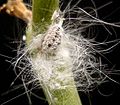Mealybugs
| Mealybugs | ||||||||||
|---|---|---|---|---|---|---|---|---|---|---|

Mealybug on Euphorbia susannae |
||||||||||
| Systematics | ||||||||||
|
||||||||||
| Scientific name | ||||||||||
| Pseudococcidae | ||||||||||
| Heymons , 1915 |
The mealybugs (Pseudococcidae), also called mealybugs , are a family of the scale insects (Coccoidea). Their trivial names are explained by their hair, which is often woolly and smears on contact.
features
The mealybird family includes around 1000 species, which differ in the length of the tail threads and the type of hairiness. They reach a body length of one to twelve millimeters. The body segmentation is always visible from above. There is a wreath of thorns on the edge of the body. The most common species in Central Europe is the citrus smear louse ( Planococcus citri ). For some years now, the long-tailed mealybug ( Pseudococcus longispinus ) has also been establishing itself .
Occurrence
Mealybugs occur worldwide. The females are phloem suckers and can be found on practically all parts of the plants. In most species, the females live stationary after they have sucked on the host plant . In some species, such as those of the genus Phenacoccus , for example , they remain mobile and change location to eat, lay eggs, moult and hibernate. Some species known as root lice only suckle at the roots of the host plants, always live underground and are therefore difficult to spot. In potted plants , they can be recognized by the typical white smear marks on the inner walls of the pot (when repotting ).
Very long-haired species on a Euphorbia
Very small, almost naked species on Pelecyphora asseliformis
Some species produce very dense wax hairs that protect them from enemies and also allow them to withstand very low temperatures of down to −40 ° C. Other species, such as the root lice that live underground, are almost bare and only mealy coated. Most species lay their eggs in a protective (hairy) wax cover. Eggs are usually laid in the warmer seasons, with hundreds of eggs being laid. In a year, one or two emerge, under very favorable conditions such as B. in a greenhouse up to eight generations . In contrast to the armored scale insects , most mealybird species prefer herbaceous plants , in nature mainly grasses , composites and legumes . In cultivated and ornamental plants , citrus plants , sugar cane , grapevines , pineapple plants , cassava , orchids , cacti and other succulents are often attacked. The pineapple grease louse ( Dysmicoccus brevipes ) and Dysmicoccus neobrevipes are two of the main pests on pineapple plants.
Combat
Ladybirds , lacewing and parasitic wasps, for example , are suitable for the biological control of mealybugs . The ladybird species Cryptolaemus montrouzieri , which comes from Australia , is specially bred and marketed for this purpose. It should be noted, however, that this is a species not originally native to Europe, which may cause problems similar to that of the Asian ladybird . This was introduced for biological pest control in glass houses, from which it escaped and is now spreading rapidly in Europe as a neozoon.
Since the eggs of the lice are often in the ground and the pests are therefore also on the plant roots, when potted plants are infested, the soil must be discarded and the roots carefully rinsed with water. Whether it helps to move the infected plant into a new pot afterwards with new soil must be tried out.
A solution of twelve grams of paraffin oil per liter of irrigation water can be used for indoor plants . The aqueous solution of around 1% soft soap not only serves to mix the substances, but also dissolves the water-repellent wax armor of the animals. Aqueous solutions for spraying are available from specialist retailers.
A useful control measure in the event of infestation by cacti is spraying with pure denatured alcohol: The denatured alcohol penetrates the body shell of the mealybugs and kills them very quickly. Repotting is recommended as soon as possible.
Some systemic insecticides ( Imidacloprid , Thiacloprid , Dimethoat ) are approved for the control of mealybugs and mealybugs, but the toxicity to humans and other “non-target organisms” such as beneficial insects should be considered.
literature
- Yair Ben-Dov: A systematic catalog of the mealybugs of the world (Insecta: Homoptera: Coccoidea: Pseudococcidae and Putoidae) with data on geographical distribution, host plants, biology and economic importance . Intercept, Andover 1994, ISBN 1-898298-07-6 .
- K. Günther, H.-J. Hannemann, F. Hieke, E. Königsmann, H. Schuman: Urania animal kingdom - insects . Urania, Leipzig, Jena 1994, ISBN 3-332-00498-0 .







